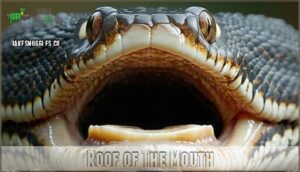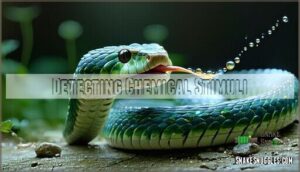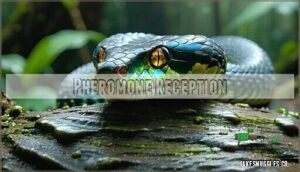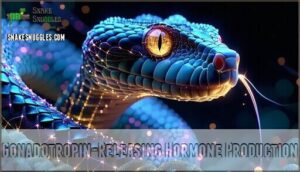This site is supported by our readers. We may earn a commission, at no cost to you, if you purchase through links.
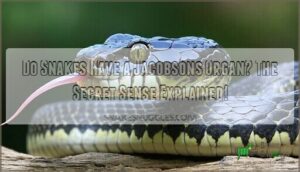 Yes, snakes do have a Jacobson’s organ. This specialized sensory structure sits in the roof of their mouth and works like a chemical detector.
Yes, snakes do have a Jacobson’s organ. This specialized sensory structure sits in the roof of their mouth and works like a chemical detector.
When you see a snake flicking its forked tongue, it’s collecting scent particles from the air and transferring them to this organ. The Jacobson’s organ then processes these chemicals, helping snakes locate prey, identify predators, and find mates.
Think of it as a combination of taste and smell rolled into one super-sense. This organ connects directly to the snake’s brain, making it essential for survival.
Understanding how this remarkable system works reveals fascinating secrets about snake behavior.
Table Of Contents
- Key Takeaways
- Snakes Sense Organs
- Do Snakes Have Jacobsons Organ
- Jacobsons Organ Location
- Snake Jacobsons Organ Function
- Jacobsons Organ in Animals
- Snake Smelling Mechanism
- Jacobsons Organ Importance
- Snake Sensory Abilities
- Jacobsons Organ Evolution
- Jacobsons Organ Significance
- Frequently Asked Questions (FAQs)
- Do humans have Jacobson’s organ?
- What organ do snakes use to smell?
- Where is the Jacobson organ on a rattlesnake?
- What does it mean when a snake sticks its tongue out?
- How do snakes use their tongues to detect scents?
- What are vomeronasal organs?
- How do snakes use their sense of smell to find prey?
- Do all snakes have a well-developed Jacobsons organ?
- What is the purpose of the Flehmen response?
- Can snakes smell underwater with Jacobsons organ?
- Conclusion
Key Takeaways
- You’ll find that all snakes have a Jacobson’s organ – a specialized chemical detector located on the roof of their mouth that works like a super-powered scent analyzer, helping them track prey, find mates, and navigate their world through chemical signals.
- You’re watching chemical analysis when snakes flick their tongues – their forked tongues collect scent particles from the air and transfer them directly to the Jacobson’s organ, creating a "stereo smelling" system that provides directional tracking with remarkable precision.
- You can’t replicate what snakes accomplish with this organ – while humans have a vestigial version that doesn’t work, snakes use their Jacobson’s organ to detect pheromones, identify specific prey species from meters away, and process chemical information that regular smell can’t capture.
- You’re seeing millions of years of evolution at work – this organ first appeared in ancient amphibians and reached peak sophistication in snakes, making them living chemical detectives that can hunt effectively even in complete darkness through scent alone.
Snakes Sense Organs
You might think snakes can’t smell much without noses like yours, but they’ve got something even better.
Snakes use special sense organs that work together to create a powerful chemical detection system that helps them hunt, find mates, and stay alive, which is a powerful tool for their survival.
Jacobson’s Organ Structure
Looking inside a snake’s mouth, you’ll find the Jacobson’s organ positioned directly on the palate.
This snake vomeronasal organ consists of two fluid-filled sacs packed with specialized nerve endings.
The reptile Jacobson’s organ maintains a vital brain connection for instant chemical processing.
Each receptor specialization allows the snake organ location to detect specific molecules that regular nostrils can’t capture effectively.
Vomeronasal Organ Function
The snake vomeronasal organ processes chemical signals through specialized receptors that detect pheromones and environmental cues.
When you watch snake tongue flicking, those collected particles activate G-protein-coupled receptors for chemical communication.
This snake chemoreception system enables precise pheromone processing for mate selection and prey detection, making the Jacobsons organ function essential for survival in their chemical world.
Snakes use their tongues to collect environmental chemical particles.
Snake Olfactory System
You’ll discover that snake olfaction operates through a dual-system approach combining traditional smell with specialized chemoreception.
Environmental adaptation has refined their scent discrimination abilities over millions of years through olfactory evolution.
This sophisticated prey tracking system enables aquatic olfaction in water-dwelling species, while the snake vomeronasal organ and snake Jacobsons organ work together, making Jacobsons organ function essential for survival.
Do Snakes Have Jacobsons Organ
Yes, snakes absolutely have a Jacobson’s organ! This remarkable sensory adaptation is present in all snake species and represents one of nature’s most sophisticated chemical analysis systems.
The snake Jacobsons organ serves as their primary tool for understanding their environment through reptilian chemoreception. Your typical snake’s sensory system relies heavily on this organ because their eyesight isn’t great.
The snake olfaction process works differently from mammals – it’s like having a built-in chemistry lab. This evolutionary advantage allows snakes to detect chemical signals that regular noses can’t pick up.
The organ development in snakes is so advanced that it’s become their most important sense. Unlike humans who depend on sight, snakes navigate their world through how snakes smell using this specialized organ. It’s their secret weapon for survival.
They also use their forked tongue to enhance air sample collection.
Jacobsons Organ Location
You’ll find the Jacobson’s organ sitting on the roof of a snake’s mouth, positioned directly above the nasal cavity where it can quickly analyze chemical information.
This specialized organ connects straight to the snake’s brain, allowing it to process scent data faster than you can blink, utilizing its unique structure to enable rapid analysis.
Roof of The Mouth
When you examine a snake’s mouth anatomy, you’ll find the Jacobsons organ positioned directly on the roof mouth area.
This vomeronasal organ sits within the palatal structure, separate from regular taste buds and salivary glands.
Unlike mammals’ oral health systems, snakes evolved this specialized snake Jacobsons organ for chemical detection rather than digestion, making their snake anatomy uniquely adapted for survival.
Above The Nasal Cavity
Picture the Jacobsons organ positioned like a hidden chamber above your snake’s nasal passage.
This vomeronasal organ sits strategically within the skull anatomy, nestled between sinus cavities and connected by cranial nerves.
The organ proximity to nasal structures isn’t coincidental—it’s perfectly placed to analyze chemicals that can’t reach regular smell receptors.
This snake sensory system represents evolutionary engineering at its finest, with the vomeronasal organ playing a crucial role in detecting pheromones and other chemical signals, making it a key component of the Jacobsons organ.
Connection to The Brain
The snake’s Jacobsons organ connects directly to specific brain regions through dedicated neural pathways.
When you observe a snake flicking its tongue, chemical signals travel instantly to the accessory olfactory bulb for rapid signal processing.
This vomeronasal organ creates seamless sensory integration, allowing the snake’s brain to trigger immediate behavioral responses for hunting, mating, or avoiding danger.
Snake Jacobsons Organ Function
When you think about how snakes experience their world, you’ll discover that Jacobson’s organ acts like a super-powered chemical detector that helps them survive.
This specialized organ processes scent particles from their tongue flicks, allowing snakes to identify prey, find mates, and navigate their environment with remarkable precision.
Detecting Chemical Stimuli
When you watch a snake flick its tongue, you’re witnessing chemical analysis in action.
Your snake’s tongue is actually a sophisticated chemical laboratory in disguise, collecting invisible scent data with every flick.
The vomeronasal organ processes chemical stimuli that regular smell can’t detect. This sophisticated chemoreception system identifies specific molecules from the environment, helping snakes navigate their world through invisible chemical signatures.
- Airborne particles stick to the snake’s forked tongue during tongue-flicking
- Chemical analysis happens instantly when tongue tips touch the Jacobson’s organ
- Scent direction gets determined by comparing chemical concentrations on each tongue tip
- Prey identification occurs through unique chemical signatures left by different animals
- Chemical stimuli provide detailed environmental information beyond normal smell detection
Pheromone Reception
Within your snake’s vomeronasal organ, specialized receptors work like tiny chemical detectors, identifying different pheromones from potential mates, prey, and predators.
These reception mechanisms trigger specific behavioral responses – whether it’s tracking down dinner or finding a partner.
The snake’s Jacobsons organ processes these chemical signals with remarkable precision, showcasing millions of years of evolutionary significance in pheromone diversity detection.
Gonadotropin-Releasing Hormone Production
Beyond detecting pheromones, your snake’s Jacobsons organ contains specialized esthesiocytes that trigger gonadotropin-releasing hormone production.
This vomeronasal organ creates a direct reproductive behavior link through hormone production control.
When pheromone influence reaches these cells, snake fertility responses activate automatically.
This esthesiocyte specialization transforms chemical detection into reproductive readiness, making the snake Jacobsons organ essential for successful mating cycles.
These processes may involve neuropeptide signalling systems, which play a vital role in regulating reproductive behavior.
Jacobsons Organ in Animals
You’ll find Jacobson’s organs in many animals beyond snakes, including amphibians, reptiles, and several mammals like cats, dogs, and elephants.
While humans have a vestigial version that doesn’t work, most animals use this organ to detect pheromones and chemical signals for mating and survival.
Amphibians and Reptiles
Amphibian Origins trace back millions of years when the first vomeronasal organ appeared.
You’ll find reptile Jacobsons organ development reached its peak in snakes and lizards. The animal vomeronasal system shows incredible Sensory Evolution across species.
- Amphibians developed basic chemoreception for Aquatic Adaptations
- Reptilian Diversity showcases advanced vomeronasal organ structures
- Terrestrial Challenges drove sophisticated snake Jacobsons organ evolution
Mammals With Jacobsons Organ
Most mammals possess a functional vomeronasal system that detects mammalian pheromones through specialized esthesiocytes.
You’ll notice cats and dogs displaying the Flehmen Response when they curl their lips to access their accessory olfactory organ.
Unlike reptiles Jacobsons organ, mammalian versions show significant organ variation in size and function.
These sensory adaptations help mammals recognize mates, territory markers, and social hierarchies through chemical communication.
Snakes use their forked tongues to enhance directional scent tracking.
Vestigial Organ in Humans
Humans possess a vestigial Human VNO that’s considered an Evolutionary Remnant of our animal ancestors.
This accessory olfactory organ contains esthesiocytes but lacks the robust functionality seen in other mammals’ animal vomeronasal system.
Scientists debate its Potential Activation and Genetic Basis.
While structurally present, it doesn’t produce gonadotropin-releasing hormone like functional versions, sparking ongoing Functional Debate about its role in our olfactory system.
Snake Smelling Mechanism
You’ll discover how snakes use their forked tongues like chemical detectors to gather scent particles from the air around them.
When they flick their tongues, they’re actually collecting airborne chemicals that their Jacobson’s organ processes to track prey, find mates, and navigate their environment, using their tongues as chemical detectors.
Tongue Flicking
You’ve probably watched a snake’s tongue dart in and out rapidly – that’s their primary way of gathering scent information.
The forked tongue creates air eddies that capture chemical particles from the environment, with flicking frequency increasing when they detect interesting scents.
You can even find snake-related enrichment items to encourage this behavior.
- Particle Capture – The split tongue tips collect molecules from different directions
- Air Eddies – Rapid movement stirs air to gather more scent particles
- Directional Cues – Each fork samples separate areas for location tracking
- Scent Intensity – Faster flicking indicates stronger chemical signals detected
Airborne Chemical Detection
When you watch a snake flick its tongue, you’re seeing airborne chemical detection in action.
The forked tongue creates air eddies that boost particle capture efficiency from scent plumes.
This chemoreception system processes complex chemical signals from the environment.
Factors like wind and humidity affect how well snakes detect airborne odours through their specialized tongue flicking behavior.
Snakes use this to enhance their smelling mechanism products.
Stereo Smelling
When snakes flick their forked tongues, they create air eddies that capture chemical particles for stereo smelling.
This bifurcated tongue design enables scent comparison between both tips, providing directional tracking capabilities through chemoreception.
Key aspects of snake stereo smelling:
- Tongue bifurcation allows simultaneous scent detection from different directions
- Air eddies help gather more chemical particles during tongue flicking
- Scent intensity comparison guides accurate prey detection
- Directional tracking occurs through paired vomeronasal organs
- Stereo smelling creates three-dimensional scent maps for navigation
Jacobsons Organ Importance
You can’t understand how vital the Jacobson’s organ is until you realize it controls a snake’s entire survival strategy.
This specialized organ lets snakes detect prey from several meters away, find mates during breeding season, and avoid dangerous predators through precise chemical analysis, which is crucial for a snake’s survival and makes the organ indispensable.
Survival and Mating
Your snake’s Jacobson’s organ acts like a chemical GPS system for life’s most important moments.
It detects mate selection signals through chemical communication, helping snakes find partners and achieve reproductive success.
This organ also guides hunting strategies by processing snake chemical signals from prey.
Environmental adaptation depends on this system, making snake communication and mate finding possible through sophisticated chemical detection, which is crucial for reproductive success.
Prey Detection
When you watch a snake hunt, you’re witnessing chemical cues in action.
The Jacobson’s organ processes scent particles collected by the forked tongue, creating a detailed map for tracking prey.
This system enables precise strike accuracy during nocturnal hunting, while heat detection helps locate warm-blooded targets.
Here’s how this incredible prey detection works:
- Chemical signals create invisible trails leading straight to unsuspecting meals
- Tongue function acts like a sophisticated GPS system for hungry hunters
- Scent particles reveal prey location with pinpoint precision
Social Behavior
Many species use their Jacobson’s organ to navigate complex social behavior patterns.
You’ll find snakes detecting chemical messages during courtship rituals and mating signals through precise pheromone analysis.
This remarkable organ helps identify aggression displays and establishes social hierarchy among competing individuals.
Snake senses enable recognition of sexual behavior cues, while some species even coordinate cooperative hunting through shared chemical communication, which involves complex social behavior patterns.
Snake Sensory Abilities
You’ve learned about the Jacobson’s organ, but snakes possess several other fascinating sensory abilities that help them survive.
While they can’t see or hear like you do, snakes use vibrations, heat detection, and specialized organs to navigate their world with remarkable precision.
Poor Eyesight
Unlike humans, you’ll find that snakes have significant visual limitations.
Most snakes are short-sighted and can only see blue, green, and ultraviolet light.
Their eyes use a transparent spectacle scale instead of eyelids for protection.
The round lens moves back and forth like a telescope to focus.
Snake retinas contain unique double cones that help process light differently than other reptiles, which is a key aspect of their visual system.
Hearing and Vibrations
Unlike their sharp vision, snakes can’t hear airborne sound waves through traditional ears.
Instead, they’re incredibly sensitive to ground vibrations that travel through their jawbone vibrations directly to their inner ear.
This unique hearing system helps with balance maintenance and spatial orientation.
When you walk nearby, they’ll detect those vibrations long before seeing you approach, which is crucial for their spatial orientation.
Infrared Receptors
Beyond feeling vibrations, certain snakes possess remarkable heat sensing abilities through specialized pit organs.
Pit vipers have facial pits below their nostrils, while boa constrictors and pythons feature labial pits on their lip scales.
These organs detect infrared radiation from warm-blooded prey with incredible thermal sensitivity.
You can even find an infrared snake detector online.
This infrared evolution makes nocturnal hunting incredibly effective, even in complete darkness.
Jacobsons Organ Evolution
You’ll find that the Jacobson’s organ first appeared in ancient amphibians millions of years ago as a simple chemical detector.
This remarkable organ then developed into a highly specialized system in reptiles like snakes, while mammals kept modified versions that work differently than their reptilian cousins.
Origin in Amphibians
Ancient amphibians first developed this remarkable sensory system millions of years ago.
Millions of years ago, amphibians unlocked the secret to chemical superpowers that snakes perfected today.
You’re looking at the roots of chemoreceptor evolution, where early tetrapods created an outpocketing from their nasal sac.
The amphibian ancestry laid the foundation for what would become Jacobson’s organ in modern snakes and lizards.
The organ development began as a simple chemical detector in these primitive creatures, evolving into today’s sophisticated sensory organs through sensory evolution.
This is an example of convergent body plans seen in squamates.
Development in Reptiles
Reptiles evolved more sophisticated scent detection than their amphibian ancestors. During embryonic development, genetic factors guide how snakes smell through specialized organogenesis stages.
Environmental influences shape their forked tongue design, allowing scent particles collection. You’ll find developmental abnormalities rarely affect this critical system because:
- Strong genetic programming protects organ formation
- Multiple backup pathways guarantee proper development
- Environmental pressures favor functional smelling with tongue
- Natural selection eliminates faulty sense of smell variants, ensuring proper development and functional smelling with a forked tongue.
Variations in Mammals
While reptiles perfected their vomeronasal systems, mammalian VNO shows dramatic functional differences across species.
You’ll find cats and dogs displaying the Flehmen Response when detecting pheromones, while primate VNO varies substantially between species.
Some mammals retain full organ function, but others experience organ regression, and unlike snakes’ forked tongue mechanism for smelling with tongue, mammals developed diverse chemical detection methods for survival behaviors.
Jacobsons Organ Significance
You’ll discover that the Jacobson’s organ represents one of nature’s most remarkable sensory adaptations, giving snakes abilities that humans can’t even imagine.
This specialized organ doesn’t just help snakes survive – it transforms them into chemical detectives that can track prey, find mates, and navigate their world through scent alone, making them chemical detectives.
Unique Sensory System
You’ll find snakes possess remarkable sensory integration that combines multiple sensory modalities for enhanced perception accuracy.
Their sense of smell works alongside signal processing from the forked tongue, creating environmental adaptation unlike any other animal.
When snakes detect scent particles through prey detection systems, their brain coordinates these inputs perfectly, giving them extraordinary survival advantages through precise sensory coordination.
Adaptations for Survival
You’ll discover that Jacobson’s organ powers remarkable hunting strategies.
This chemical-sensing powerhouse transforms snakes into precision predators through enhanced prey tracking abilities and chemical cue detection.
Survival adaptations include:
- Enhanced sense of smell – Detecting prey from several meters away
- Snake prey detection – Identifying specific species through chemical signatures
- Snake hunting efficiency – Following scent trails with pinpoint accuracy
- Thermal regulation – Coordinating with heat sensors for ideal strikes
Comparative Biology
You’ll find fascinating differences when comparing Jacobson’s organs across species.
All squamate animals like snakes and lizards possess this vomeronasal system, while turtle absence shows evolutionary divergence.
Mammalian similarities exist in cats and dogs, which display the flehmen response when using their chemoreceptors.
Primate function varies, with humans having only vestigial organs for chemical detection and tastescenting.
Frequently Asked Questions (FAQs)
Do humans have Jacobson’s organ?
You’ve got a vestigial version that’s underdeveloped and non-functional.
Unlike snakes who rely on theirs for survival, your Jacobson’s organ sits dormant in your nasal cavity, a leftover from evolutionary history.
What organ do snakes use to smell?
Snakes use their forked tongues and Jacobson’s organ to smell.
You’ll see them flick their tongues to collect scent particles, which they transfer to this specialized organ located on their mouth’s roof for chemical analysis, utilizing their forked tongues.
Where is the Jacobson organ on a rattlesnake?
Temperature differences as small as 6°C can be detected by rattlesnakes.
You’ll find the Jacobson’s organ positioned on the roof of their mouth, directly above the palate, where it analyzes chemical particles collected by tongue flicking.
What does it mean when a snake sticks its tongue out?
When you see a snake flicking its tongue, it’s collecting chemical information from the air.
The forked tongue gathers scent particles and transfers them to the Jacobson’s organ for analysis, helping detect prey, predators, or mates, which involves a process of collecting and analyzing chemical information.
How do snakes use their tongues to detect scents?
Like underwater explorers using sonar, you’ll see snakes flick their forked tongues to collect chemical particles from the air.
Then transfer these scents to their Jacobson’s organ for precise analysis and tracking.
What are vomeronasal organs?
Vomeronasal organs are specialized chemical detectors you’ll find in many animals’ mouths.
They’re also called Jacobson’s organs and work like super-sensitive smell sensors, detecting pheromones and heavy odor particles that regular noses can’t catch.
How do snakes use their sense of smell to find prey?
Picture a bloodhound tracking a scent trail – that’s how snakes hunt.
You’d be amazed: they flick their forked tongues to collect chemical particles, then transfer them to their Jacobson’s organ for precise prey detection and directional tracking.
They use this unique method for precise prey detection, making them efficient hunters.
Do all snakes have a well-developed Jacobsons organ?
Yes, you’ll find that all snakes possess a well-developed Jacobson’s organ.
This specialized chemical detector sits on their mouth’s roof, helping them track prey, find mates, and navigate their world through sophisticated scent analysis.
What is the purpose of the Flehmen response?
Ever wonder why cats curl their lips after sniffing something?
The Flehmen response helps animals transfer scent molecules to their vomeronasal organ, allowing them to better analyze pheromones and chemical information from their environment.
Can snakes smell underwater with Jacobsons organ?
Snakes can’t effectively use their Jacobson’s organ underwater since it requires air particles collected by tongue-flicking.
However, they can still detect some dissolved chemicals through their regular sense of smell while submerged.
Conclusion
Deciphering nature’s chemical secrets, snakes possess one of evolution’s most fascinating sensory tools.
Yes, do snakes have a jacobsons organ – and this remarkable structure transforms them into living chemical detectors.
You’ve discovered how their forked tongues and specialized vomeronasal systems create a world we can’t imagine.
This incredible adaptation helps snakes survive, hunt, and reproduce with precision.
Understanding their Jacobson’s organ reveals why these serpents remain such successful predators in ecosystems worldwide.
- https://www.sciencedirect.com/topics/biochemistry-genetics-and-molecular-biology/vomeronasal-organ
- https://brainly.com/question/41211022
- https://reptilehow.com/what-is-jacobsons-organ-in-snakes/
- https://biomedicalsciences.unimelb.edu.au/departments/department-of-biochemistry-and-pharmacology/engage/avru/blog/sneaky-snake-facts
- https://elementalscience.com/blogs/science-activities/how-do-snakes-smell-the-jacobson-organ?srsltid=AfmBOorAi5w3EiD2xJWNNbxjDxhZ340yy7t1gmFE3GzHbosfLn44Xvza


